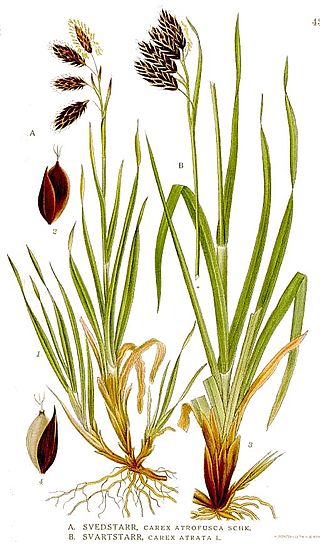
The Cyperaceae are a family of graminoid (grass-like), monocotyledonous flowering plants known as sedges. The family is large: botanists have described some 5,500 known species in about 90 genera, the largest being the "true sedges" with over 2,000 species.
Jisaburo Ohwi was Japanese botanist. He was a distinguished member of the Faculty of Science of Kyoto Imperial University. He is perhaps best known for his 1953 Flora of Japan.
Carex accrescens is a species of sedge that was first described by Jisaburo Ohwi in 1931. It is native to eastern Asia, from Siberia to the Korean Peninsula and Japan.

Carex autumnalis is a species of flowering plant in the sedge family, Cyperaceae. It was first formally named by Jisaburo Ohwi in 1930. Carex autumnalis is native to Japan and mainland eastern Asia, from southeastern China to North Korea. In China it grows in shady ravines.
Carex brachyanthera is a species of sedge that was first formally named by Jisaburo Ohwi in 1934. It is native to parts of eastern Asia and Oceania.

Carex lanceolata is a species of sedge, native to the eastern half of China, Mongolia, eastern Siberia, Korea, Sakhalin, and Japan. Its seeds are dispersed by ants.

Carex morrowii, the kan suge, Morrow's sedge, Japanese grass sedge or Japanese sedge, is a species of flowering plant in the family Cyperaceae. It is native to central and southern Japan, and has been introduced to Belgium, Denmark and Austria.

Carex kobomugi is a species of sedge, known as the Japanese sedge or Asiatic sand sedge, that lives in sandy coastal areas of eastern Asia, and has become an invasive species in the north-eastern United States.

Carex viridula, known as little green sedge, green sedge, or greenish sedge, is a small flowering plant native to North America, Europe, Asia, and Morocco.
Carex aphyllopus is a species of sedge. Its native range is Central Japan.
Carex ligulata is a species of flowering plant in the sedge family, Cyperaceae. Carex ligulata is native to Asia from India to Japan. It grows in a variety of habitats, including grasslands, forests, mountain slopes, and riparian areas.

Carex atrata, called black alpine sedge, is a widespread species of flowering plant in the genus Carex, native to Greenland, Iceland, and most of Europe, plus scattered locations across temperate Asia, including Anatolia, Siberia and the Himalaya, as far as Taiwan and Japan. Its chromosome number is 2n=52, with some variants reported, e.g. n2=54 for Greenland material.

Carex breviculmis, called the Asian shortstem sedge, is a species of flowering plant in the genus Carex, native to Asia from the Indian subcontinent to Southeast Asia, China, Taiwan, Korea, Japan, north as far as Khabarovsk Krai, and Malesia, New Guinea, Australia, Norfolk Island and New Zealand. It has been introduced to the US state of Mississippi. Typically found in forests, it is quite shade tolerant.

Carex lepidocarpa, called the long-stalked yellow-sedge, is a species of flowering plant in the genus Carex, native to eastern Canada, Morocco, and most of Europe. It is a member of the Carex flava species complex.

Carex phyllocephala is a species of flowering plant in the sedge genus Carex, family Cyperaceae. It is native to southern China, and introduced to Japan. A variegated cultivar, 'Sparkler', is commercially available.
Carex quadriflora, the four-flower sedge, is a species of flowering plant in the family Cyperaceae, native to northeastern China, the Russian Far East, the Korean Peninsula, and Japan. Its chromosome number is 2n = 46.
Carex helferi is a tussock-forming species of perennial sedge in the family Cyperaceae. It is native to parts of South East Asia.

Carex dissitiflora is a tussock-forming species of perennial sedge in the family Cyperaceae. It is native to parts of Japan and Taiwan.
Carex chinoi is a tussock-forming species of perennial sedge in the family Cyperaceae. It is native to parts of Japan.











